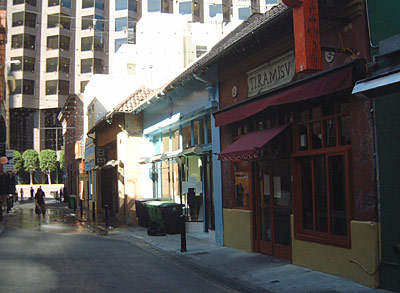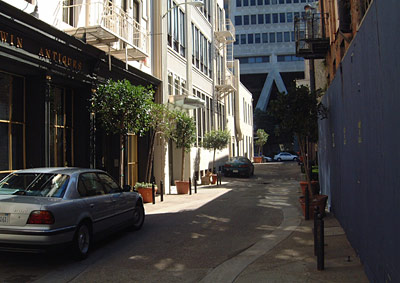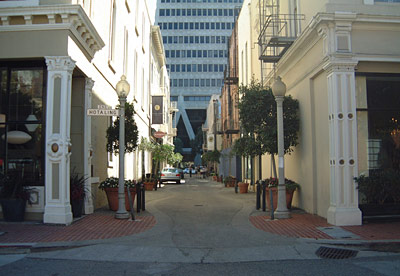Discovering secret geography -- the alleys and small streets, often with shops and restaurants, that are largely invisible from major streets -- you begin to feel ownership over a slice of the city.
 As a recent transplant to San Francisco, I've begun to think that it may well be the most beautiful city in the country. No zealot like a convert, I guess. But I've figured out one of the city's aesthetic tricks-something I've started calling "secret geography," though I'm sure smarter thinkers on urban design have better language. I'm talking about alleys and small streets, often with shops and restaurants, that are largely invisible from major streets unless you're looking for them. They're a more intimate, human-scaled urban experience literally in the shadows of skyscrapers.
As a recent transplant to San Francisco, I've begun to think that it may well be the most beautiful city in the country. No zealot like a convert, I guess. But I've figured out one of the city's aesthetic tricks-something I've started calling "secret geography," though I'm sure smarter thinkers on urban design have better language. I'm talking about alleys and small streets, often with shops and restaurants, that are largely invisible from major streets unless you're looking for them. They're a more intimate, human-scaled urban experience literally in the shadows of skyscrapers.
My favorite example is Belden Pl., 100 meters of restaurants cutting between Pine and Bush, parallel to Kearny and Montgomery. Walking along Kearny, the only hint that eight high-quality restaurants lurk a few steps away is a neon sign high up along the Bush side of the alley. If you're driving, the sign's nearly invisible. The restaurant fronts are brightly colored, with Spanish-tile faux roofs. Low iron stanchions delimit the narrow sidewalks (more for show, since gates at either end of the alley can block out automobile traffic).




But at night Belden's magic really shows. On a recent warm evening, the alley was packed with diners eating outside, family-style tables packed in wall to wall. And above them strings of white Christmas lights glowed. It's a simple thing, but it speaks to cooperation among restaurant owners, who know that diners are as likely to show up at Belden Place to eat at one restaurant as at any other, I imagine. The lights set up a unique, magical space that, despite how crowded and popular the restaurants are, still manages to feel special and exclusive. And the night I drank Lillet at Plouf, the lights at the Pine end of the alley were off -- and no one was eating at the tables under the dark bulbs.
A more subtle byway is Hotaling Pl., a narrow lane between Jackson and Washington that terminates at the foot of the famous TransAmerica pyramid. It's in the heart of a historic district called Jackson Square, two- and three-story brick buildings dating to the 1800s that now house galleries, law offices and antique stores. Hotaling has one of those antique shops, a high-windowed, green and gold storefront. It also has, maybe most notably, the back door to the Bubble Lounge, a popular nightclub.
But instead of hiding this door, Bubble Lounge celebrates it with a banner and two ornamental streetlights. Next door, the Villa Taverna has its own ornamentation-more lights, and an ancient Roman-styled relief above the door (with two brass plaques reading "private club" and "members only"). At the Washington end is Elisabeth Daniel, one of the city's best restaurants. Hotaling is Elisabeth Daniel's gallery and advertisement, with windows displaying the bustling kitchen and an array of fancy glassware. Stanchions topped with tiny horseheads and (more importantly, I think) a wavy pattern molded into the pavement distinguish the alley's space from the streets around it. Walking along Hotaling you're aware at an unconscious level that it's a microcosm, a cool side street that, were it less well-planned, might've been a grimy back alley.
Finally, just a block away from Hotaling is Gold St. It actually forms a T with another alley at mid-block, the wonderfully-named Balance (there's obviously a lot to love about the intersection of Balance and Gold-recently telephone poles there and at Hotaling announced hearings to approve the imminent closure of both alleys for a couple days in October for a wedding reception and a rehearsal dinner).
There's not much on Gold besides a hip restaurant-jazz club built into a historic brick building. The joint has a neon sign and blue lights to illuminate the entrance, and even Zagat, Rosetta Stone for decoding any city's foodie culture, says the bar is a place for locals in the know. That's the power of an alley, the ability to convey the illicit excitement of a speakeasy.
The lesson of secret geography isn't lost on designers of theme parks or so-called "urban entertainment destinations" like Los Angeles' Grove at Farmers' Market or West Palm Beach's CityPlace. Both of them have main thoroughfares, echoing great European streets like Barcelona's Las Ramblas. And both have smaller shops on narrower corridors that mimic side streets (even though they often lead to parking structures).
As a fellow fan of cities pointed out to me in college, side streets reward explorers with discoveries that feel exclusive even though they're actually quite egalitarian -- anyone can walk the streets of a great souk. Even better, in decoding secret geography you begin to feel some ownership over a slice of the city -- and you start to honestly believe that your town is the most beautiful one in the country.
Adam Rogers is a Senior Associate Editor at Wired magazine in San Francisco. He was a 2002-2003 Knight Science Journalism Fellow at the Massachusetts Institute of Technology, where he focused on urban ecology and design.

Planetizen Federal Action Tracker
A weekly monitor of how Trump’s orders and actions are impacting planners and planning in America.

Restaurant Patios Were a Pandemic Win — Why Were They so Hard to Keep?
Social distancing requirements and changes in travel patterns prompted cities to pilot new uses for street and sidewalk space. Then it got complicated.

Map: Where Senate Republicans Want to Sell Your Public Lands
For public land advocates, the Senate Republicans’ proposal to sell millions of acres of public land in the West is “the biggest fight of their careers.”

Orange County, Florida Adopts Largest US “Sprawl Repair” Code
The ‘Orange Code’ seeks to rectify decades of sprawl-inducing, car-oriented development.

Maui's Vacation Rental Debate Turns Ugly
Verbal attacks, misinformation campaigns and fistfights plague a high-stakes debate to convert thousands of vacation rentals into long-term housing.

San Francisco Suspends Traffic Calming Amidst Record Deaths
Citing “a challenging fiscal landscape,” the city will cease the program on the heels of 42 traffic deaths, including 24 pedestrians.
Urban Design for Planners 1: Software Tools
This six-course series explores essential urban design concepts using open source software and equips planners with the tools they need to participate fully in the urban design process.
Planning for Universal Design
Learn the tools for implementing Universal Design in planning regulations.
Heyer Gruel & Associates PA
JM Goldson LLC
Custer County Colorado
City of Camden Redevelopment Agency
City of Astoria
Transportation Research & Education Center (TREC) at Portland State University
Camden Redevelopment Agency
City of Claremont
Municipality of Princeton (NJ)


























